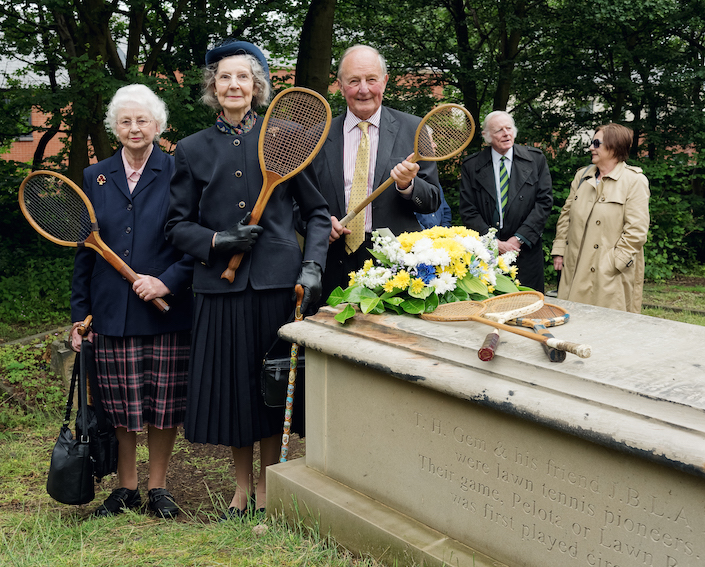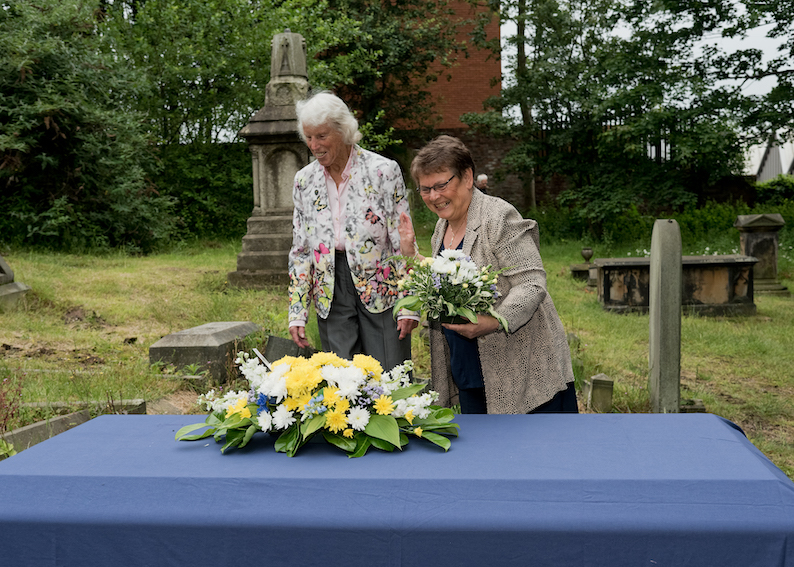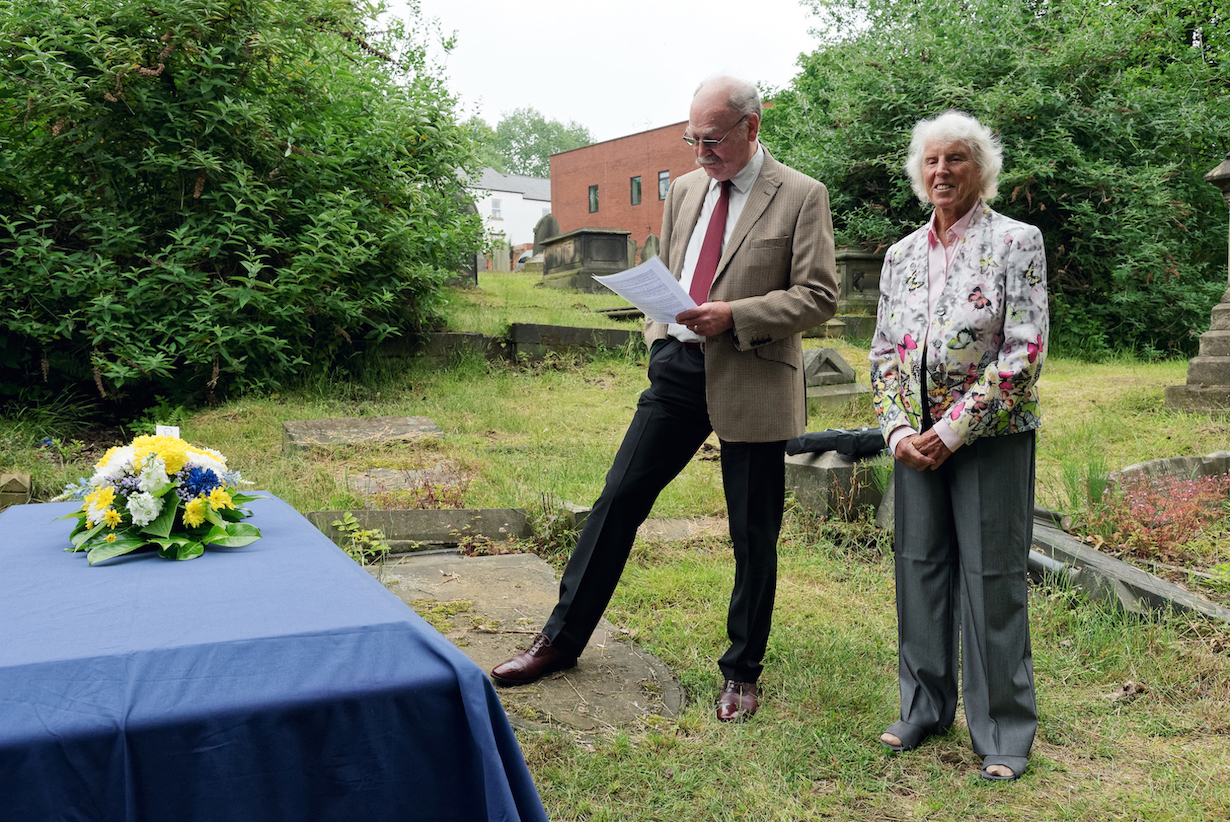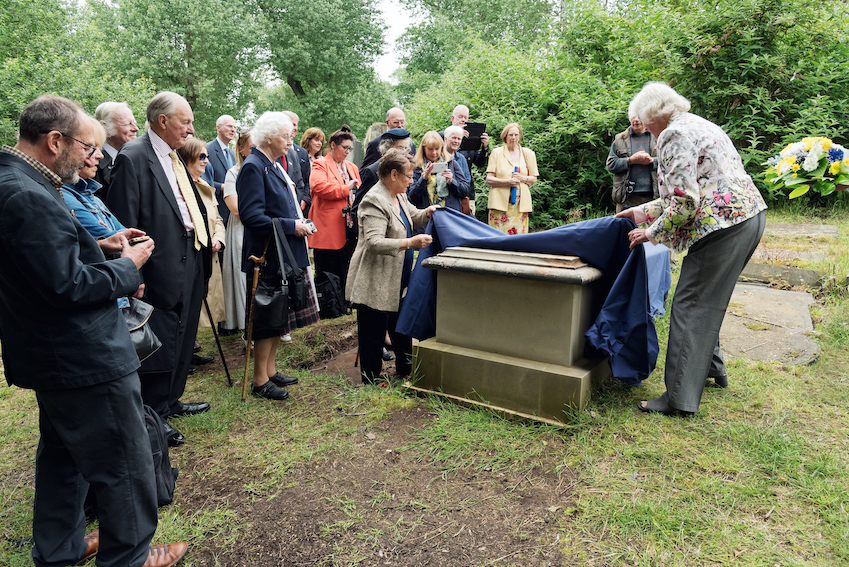The restored grave of Harry Gem, Victorian lawn tennis pioneer, was unveiled on Wednesday, 26th June 2019, by Ann Jones, who this year celebrates the golden anniversary of her winning the singles title at the Wimbledon Championships in 1969.
Guests at the event in Warstone Lane Cemetery, at the heart of Birmingham’s famous Jewellery Quarter, included Gem family descendants Sir Benjamin Bathurst, Mrs Hazel Paton and Mrs Sheila Thompson.
The completion of the restoration of Harry Gem’s grave sees the fruition of a project the roots of which date back to a conversation nearly a quarter of a century ago. Robert Holland, a local lawn tennis enthusiast, Honorary Secretary of Edgbaston Archery & Lawn Tennis Society in the 1990s, was talking to the chairman Alan Broadhead who mentioned that he thought the club might be the oldest lawn tennis club in the world. This started Robert off on extensive research into the early history of lawn tennis in Birmingham. Whilst establishing that Edgbaston Archery & LTS is indeed the oldest lawn tennis club in the world, a trawl of the Society’s membership archive revealed that Harry Gem and his wife had been members back in the 1860s.
Reading up on Harry’s life story (b. 1819 – d. 1881) indicated that he was buried in Warstone Lane Cemetery and enquiries provided the plot number. Robert was able to pinpoint the grave’s location but there was no gravestone in evidence. In 2010, along with other enthusiasts, Robert set up the Harry Gem Project with a view to restoring Harry’s grave and promoting the lawn tennis pioneering story of Harry and his friend Augurio Perera. In the same year Michael Reddy, a local tour guide, was the first to mark the grave, appropriately enough with a tennis ball on an urn!
In 2013 Robert and co-trustees Chris and Sue Elks obtained permission to investigate the grave site. Their excavations revealed nothing but broken masonry. On replacing the soil it was decided to check the adjacent grave site in case any stone had been moved. Under six inches of earth they found the ledger stone to Harry’s grave and the campaign to restore the grave began in earnest.
Since then Robert and The Harry Gem Project acquired the necessary permissions and fund raising began in late 2017. “I envisaged that raising the money would be a considerable challenge,” commented Robert. “However, there was great support and interest in the project from many quarters, including individuals, descendants of the Gem family, charitable trusts, the Friends of Key Hill & Warstone Lane Cemeteries, the City of Birmingham, the LTA, the All England Club and the Royal Spanish Tennis Federation.”
By August 2018 the finance was in place and Midland Conservation Limited were commissioned to construct the new grave architecture. In addition, Harry’s wife’s details were to be engraved on the ledger stone, as this had not been done at the time she was buried in 1899. The opportunity was taken also to record on the grave both Gem and his friend Perera’s importance as lawn tennis pioneers. The following inscription appears on one of the side panels: “T.H. Gem and his friend J.B.L.A. Perera were lawn tennis pioneers. Their game, Pelota or Lawn Rackets, was first played circa 1859.”
“It has taken a while,” says Robert, “but we are delighted with the end result and, by way of a bonus, it is finished in time for the 200th anniversary of Harry’s birth in 2019.”
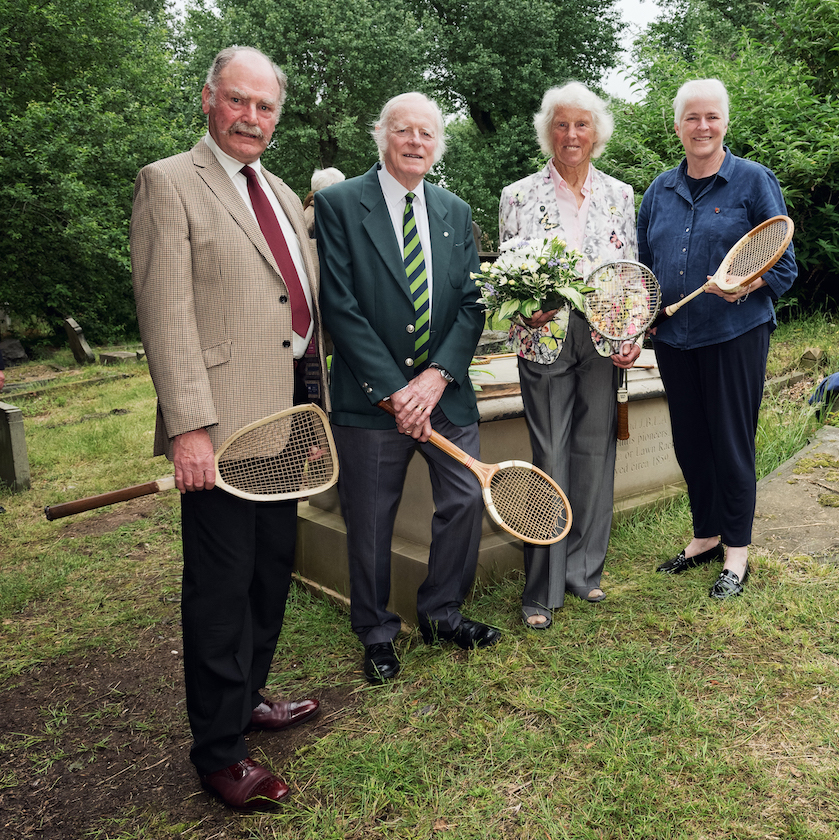
Robert Holland, Vic Lyttle, trustee Edgbaston Archery & Lawn Tennis Society, Ann Jones, Judy Dyke, Trustee Limoges Charitable Trust
Robert’s graveside address:
“It is a very great pleasure to welcome you all to the unveiling Harry Gem’s restored grave and I must thank everyone for their generous support, which has enabled us to see this project through to completion.
First of all, some introductions:
I am Robert Holland a trustee of the Harry Gem Project along with Chris and Sue Elks and Vic Lyttle.
Our guest of honour today is a lady who achieved at the highest level of lawn tennis and ranked world number two. She amassed over 110 singles and doubles titles. She won a French Doubles title and Mixed Doubles titles at both the French and Wimbledon Championships. She was a finalist in the Australian and US Championships. She was French Singles champion not once but twice and she became Wimbledon Singles Champion back in 1969, the crowning glory of any lawn tennis career. Please welcome Ann Jones, ladies and gentlemen.
We are delighted to have several guests here today with connections to the Gem family:
Sisters Hazel Paton and Sheila Thompson, who are related via Harry’s great uncle William Harvey Gem and Sir Benjamin Bathurst, who traces his connection via Harry’s sister Agnes Sarah Gem.
I shall give you now a short portrait of Harry before asking Ann and Sue to unveil the grave. Following this Chris will read a newspaper report of Harry’s funeral procession. And we will then move on to the RBSA Gallery for refreshments
The completion of the restoration of lawn tennis pioneer Harry Gem’s grave is the culmination of a project, dating back to a conversation nearly a quarter of a century ago. I was talking to Alan Broadhead, then chairman of Edgbaston Archery & Lawn Tennis Society. He thought that the Society might be the oldest lawn tennis club in the world. This started me off on extensive research into the early history of lawn tennis here in Birmingham. Whilst establishing that Edgbaston Archery & LTS is indeed the oldest lawn tennis club in the world, a trawl of the Society’s membership archive revealed that Harry Gem and his wife had been members back in the 1860s.
Thus Harry entered my life, hotly pursued by his friend Augurio Perera and has been a permanent fixture ever since!
Whilst we are here to celebrate Harry as a lawn tennis pioneer, even if we put aside this aspect of his life he was still a very significant figure in Victorian Birmingham – an A-list celebrity in modern parlance. His status is underlined by the report of the size of his funeral which Chris will read later.
Harry was born in 1819 (200 years ago) and was a man of many parts. He was a lawyer, the Clerk to the Birmingham Magistrates, as his father was before him. He was a founding member and an officer in the Birmingham Volunteer Rifles. He was a leading member of the Masonic community. He was an all-round sportsman – a rackets player, real tennis player, a runner, a swimmer, and an experienced horseman. He was a founder member and Honorary Secretary of the Bath Street Racquet’s Club, down by St. Chad’s Cathedral. It was here that he must have first met Perera, who was an accomplished rackets player in his own right. He played cricket for Moseley Cricket Club and founded, with friends, a cricket club at Birchfield. He was a skilled artist, having at least one of his sketches published in Punch. He was a writer, contributing many humorous and sporting articles to various publications. He was a dramatist and a consummate actor. Not long before he died, he composed an operetta based on the trial in Pickwick Papers. He was considered a fine after-dinner speaker. He gave public readings of his favourite authors, particularly Dickens. He was responsible also for the foundation of the Birmingham Union Club – the list goes on.
According to his obituarist he was remarkable for his kindliness of heart, his great physical activity and his marvellous memory. And, in this regard, there are two events in his life which are worth relating:
Firstly, his athletic prowess:
In 1862, at the age of 43, he wagered that he could run from Deritend, Birmingham to St. Mary’s, Warwick, a distance of about 21 miles, in under three and a half hours. To maintain the dignity of his position he ran in his ordinary clothes ‘so as not to excite observation.’ Aris’s Birmingham Gazette reported, under the heading of Amateur Pedestrianism, that Harry undertook the run for a ‘trifling wager’, started at 10.56 a.m. and finished in ‘Warwick, at one minute past two p.m.’ ‘Three hours and six minutes, including stoppages.’
And as to his extraordinary memory:
At a Birchfield Cricket Club supper party a bet was made that Harry could, by merely walking once along any street, memorise and repeat accurately the names and occupations of all the inhabitants displayed on the building signboards. Without Harry’s prior knowledge, the right-hand side of Snow Hill, now Great Charles Street, from Steelhouse Lane to Summer Lane, was selected. The book was prepared and Harry and his opponent walked slowly along the street. They repaired to the cricket club where Harry repeated all the names and occupations without mistake.
The game that Harry and his friend Augurio created, as early as 1859, in the garden of Perera’s home in Ampton Road, was clearly a forerunner of the modern game of lawn tennis. However, as neither man had any commercial interest in their game, which initially they called Pelota or Lawn Rackets, it went no further than Leamington Spa where they formed the world’s first lawn tennis club in 1874.
Harry continued to live a full and eventful life with his wife Ellen Maria until June 1881 when, at the age of 62, he rode at the head of the Volunteers from Birmingham to Sutton Coldfield for their annual encampment. On arrival he suffered a seizure and was only saved from falling from his horse by the riders close to him. After a few days in hospital he was able to attend the corps inspection, albeit seated in a chair. By August he and Ellen were in Portsea, hoping the sea air would be good for his recovery. However, he suffered a stroke and returned home at the beginning of October where he died on 4th November.
So, 138 years later I now ask Ann and Sue to unveil Harry’s newly restored grave.”
Here is the full contemporary account of Gem’s funeral orocession, an edited version of which was read at the graveside by Chris Elks:
The Birmingham Daily Post, Friday, November 11, 188
FUNERAL OF THE LATE MAJOR GEM
The burial of the late Major Gem took place yesterday, at the Church of England Cemetery, Warstone Lane, and seldom has a more impressive ceremony been witnessed in Birmingham.
On account of the prominent position which the Major held in the Birmingham Rifle Volunteer Corps, with which he had been connected since its formation, the funeral was appropriately conducted with military honours, and this was the first funeral of its kind since that of Major Briggs several years ago. Not only the Birmingham Volunteers, but contingents from the Staffordshire and 2nd Warwickshire Rifle Volunteers and the 1st Worcestershire Artillery Volunteers joined in escorting the body to the cemetery, and the result was a military display of an imposing character.
The coffin was conveyed form the late Major’s residence, Portland Place, Leamington, in a hearse, attended by some members of the 2nd Warwickshire Volunteers, to the Great Western Railway Station at Leamington, and thence by train to Snow Hill Station, Birmingham, where it arrived at half-past one o’clock.
Upon the coffin, which was of polished oak, were placed the deceased’s sword, belt, and shako, around which were wreaths of choice flowers, and a Union Jack was thrown over one end. There was the simple inscription on the lid “Thomas Henry Gem, died November 4th, 1881, aged sixty-two years.” On its arrival the coffin was borne from the train to a gun-carriage outside the station by twelve of the oldest members of No. 1 Company, under the command of Quarter-master Griffiths; and Major Burt, Captain Walford, Captain Salt, and Surgeon Yates acted as pall-bearers. The gun carriage was furnished by the Balsall Heath Artillery; and the 5th Dragoon Guards, stationed at the Barracks, provided a pair of horses and a driver, under the charge of a non-commissioned officer.
For some time before the train came into the station the volunteers had assembled in the station yard, and being drawn up in open order, as the coffin passed them they presented, and then reversed their arms.
A procession, headed by a strong force of police, was then formed in the following order:-
First, the volunteer firing party, numbering about 220, under the command of Captain Brown, Captain Hart, and Captain Davis; next, the bearers and the band of the corps, then the body, immediately behind which came the deceased’s charger, harnessed in military fashion, with the Major’s boots hanging in a reversed position by the stirrups.
The horse was lead by Privates Nicholls and Wheeler, who served with in the Crimean war, and was followed by Mr H. J. Hart and a groom who usually attended to the horse.
Three mourning coaches came next, and in these were the chief mourners, Mrs Gem, the Rev. C. Gem, Mr C. S. Gem, Mr John Gem, Mr and Mrs Bullock, Miss Wilcox, Mrs Wilmot, and Mr and Mrs Watson.
Following the coaches were about 250 of the Birmingham Volunteers; then the E and F Batteries of the First Worcestershire Artillery Volunteers, numbering about 200, in full dress, under the command of Captain Deykin, and accompanied by Lieutenants Short and Taunton.
Next in order was a strong detachment of the 2nd Warwickshire Rifle Volunteers, including Major Chattock, Captains A. Ash, Cook, McGrath, Lieutenants Willmot, Glover and Blenkinsopp. Several of the Staffordshire Volunteers were also present; and following them were the officers of the Birmingham Volunteers – Lieutenant-Colonel Tarte, Captains Davis, Allcock, Hudson, Hart, Walford, Walker, A. C. Cox, Brown, Wiley, Lieutenants Gibbins, Hudson, Heaton, Simmonds, Ludlow, Tonks, Wilkes, Asbury, Corder, Whitfield, Surgeons Thompson, Freer, and Whitby, and Quartermaster Griffiths. The officers’ belt ornaments were covered with crepe bands on their left arms. A number of friends on foot, including several old volunteers, and a number of private carriages, before which walked Major Bond in full uniform, came next; and another company of volunteers brought up the rear, the whole forming a procession which extended along the greater part of New Edmund Street.
The route taken to the cemetery was along Edmund Street, the Parade, Newhall Hill, and Frederick Street, to Warstone Lane. The procession moved along slowly, the band playing the “Dead March in Saul.”
The approaches to the station were occupied by an immense assemblage of spectators, crowds lined the various thoroughfares, and the windows of nearly all the houses were filled with spectators eager to catch a glimpse of the procession as it passed by. The thoroughfares leading to the entrance of the cemetery were occupied by thousands of people, some being stationed on vehicles, and some even on the housetops. It was half-past two o’clock when the funeral cortege reached the cemetery. A halt was made at the entrance, while the firing party formed a line on each side of the drive inside. The procession then moved to the church, and the various companies having taken up the places assigned to them, the Rev. Canon Wilkinson read the first portion of the Burial Service in an impressive manner. The coffin was then borne to the grave, which is situated in the lower part of the cemetery, and is the same grave as that in which Mrs. Gem’s father was buried. The Rev. Canon. Wilkinson here concluded the service, and the Volunteers fired three volleys.
Amongst those who attended at the cemetery were the Rev. Canon Leigh (vicar of Leamington), the Rev. J. Eagles, the Rev. Hatton Jones, Dr. Jackson, Dr. Suffield, Councillor Dr. Barratt, Messres J. F. Swinburn and J. Barrows (representing the King’s Heath Bench), The Leigh Lodge of Freemasons, of which the deceased had been a member, were represented by the W.M., Mr. W. Thomas; the P.M., Dr. Underhill; and the Director of Ceremonies, Mr. A. Salt. Messrs. H. J. Whitlock, W. Thomas, R. Pollock, jun., T. F. Walker and, B. Weekes attended as a deputation from the Birmingham Amateur Dramatic Associates, and amongst others present either at the station or at the cemetery were Mr. T. C. S. Kynnersley (stipendiary magistrate), Colonel C. Ratcliff, Mr. J. B. Hebbert (magistrates’ clerk), Mr. J. H. Stone, Mr. J. Lowe, Mr. J. C. Lord, Mr. EW. O. Smith (town clerk), Mr. Loxdale Warren, Messrs. E. Gem, J. Rodgers, J. Ludlow, W. Fallows, T. C. Cheston, Dorsett, Kendall, W. E. Simmons (who joined the volunteers with Major Gem), T. E. Spenser, A. Walter Walford, B. G. Wilson, A. Turner, W. Southern (Leamington), E. B. Holmes, R. Howson, H. V. Howson, A. A. Sylvester, R. Holmes, A. Roe, W. S. Tuke, T. H. Smith, Fitter, Brindley, C. W. Barton, B. Hebert, W. King, W. G. Robins (deputy-clerk to the King’s Heath magistrates). A meeting of the Musical Festival Committee, which was being held at the same time, prevented several magistrates and others from being present.
After the funeral ceremony the Birmingham Volunteers marched to the Drill Hall in Thorp Street, where they were addressed by Major Burt, who said he thought it unnecessary to detain them long, but he wished to thank them for their presence on that sad occasion. Major Gem was so well known to them all that is was unnecessary to enlarge upon his qualities. He had been termed the “father” of that regiment, and no father had more love for his offspring than the deeply lamented friend had for that battalion. His love extended to the whole body of men, from the highest to the lowest of them all. But as soldiers they had no time for regret. They must resolve, as much as they could, to do what they could to carry out the late Major’s wishes, in order that the corps in which he had taken so much interest could prosper. With regard to the vacancy created by Major Gem’s death, he hoped before long they might be able to find an officer who would be welcome to every one of them. He did not aspire himself to the chief command, but he hoped they would not be disappointed to hear that he was going to remain with the regiment so long as his time allowed. He thanked them for the splendid muster they had made that day. The men then dispersed.
It should be mentioned that excellent order prevailed amongst the crowd owing to the efficient police arrangements carried out under the direction of Major Bond, assisted by Superintendents Wilcox, Sheppard, Stevenson, Harvey, Lomax, and Shaw; about 300 members of the force being on duty at the station, the cemetery and along the route.


